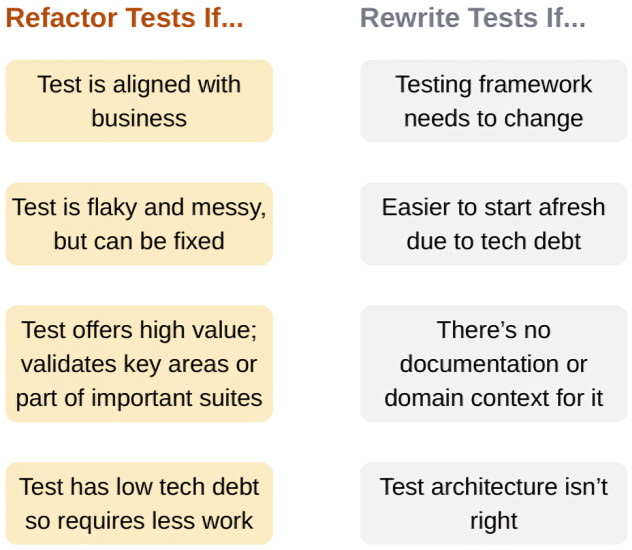When to Refactor and When to Rewrite Automation Test Cases?
|
|
Only in growth, reform, and change, paradoxically enough, is true security to be found – Anne Morrow Lindbergh.
The same holds true for software and test automation scripts. Automation test cases act as a line of defense in the quality assurance of software. Yet, one often finds themselves struggling to maintain them – the test suite that was once clean and efficient is now slow, flaky, or difficult to maintain. Maybe the test cases fail intermittently or are flaky, or they are no longer effective for validating the latest version of the software.
At such times, one might ask, “Is it time to refactor what you have, or is it better to rewrite from the ground up?”
This article will provide clear criteria and a decision-making framework to help you choose the right path for your team and product.

| Key Takeaways: |
|---|
|
Refactor vs. Rewrite

When to Refactor?
Refactoring is about making your existing tests more efficient and easier to work with, without changing what they actually do. You’re improving the internal structure of the code, not rebuilding the house from scratch.
You should consider refactoring when your tests are functional but messy. This approach is perfect for local, manageable issues that can be fixed with a targeted effort. Here are a few key scenarios:
- High ROI, Low Effort: The test does the job, but the code is confusing or sloppy. By spending a little time cleaning it up – maybe renaming a variable or pulling a block of code into a reusable method – you get a big payoff in future maintenance time.
- Code Clutter and Duplication: Do you see the same lines of code copied and pasted across multiple tests? That’s a huge red flag. Refactoring lets you consolidate that redundant code into a single, shared function. This makes your suite more manageable and reduces the risk of errors. A great example is introducing Page Object Models to centralize all the locators and actions for a specific page.
- Known and Documented Issues: The problems with the test suite are well-understood. For instance, you know that certain tests are slow because they repeat a login process unnecessarily. You can refactor them to use a single sign-on helper function.
- Poor Readability: The tests are hard to understand. Variable names are confusing, and there are no comments to explain what the code does. Refactoring helps make the code more intuitive, so new team members can get up to speed quickly. Read: Clean Code: Key Dos and Don’ts for Successful Development.
- Technical Debt: The tests work, but they were built with quick fixes and shortcuts. Over time, this “debt” slows down development. Refactoring pays down that debt by improving the code’s design. Read: What is Test Debt?
- Used in Other Testing Suites: The tests are part of your critical regression suite and are generally reliable, but they’re becoming a pain to maintain. They may not be broken, but their complexity is a growing headache. Refactoring can untangle that complexity before it becomes a full-blown problem.
- Information Available for Refactoring: If the original creator of the test is still around, or you have the required domain knowledge and documentation, then a refactor tends to be quicker.
When to Rewrite?
Sometimes, a test suite is so fundamentally broken that simple cleanups just won’t cut it. You’d choose to start over when the existing foundation is too weak to support your needs.
Here are the key indicators that it’s time for a fresh start:
- Failing to Meet Business Needs: If your tests are still running but are no longer validating the right things, they’re useless. Maybe the product has evolved, and the old tests are now targeting obsolete features. You’re getting a false sense of security, while a new test suite is needed to cover the current functionality.
- Inexplicable Flakiness: Tests that fail for no clear reason are a productivity drain. You and your team spend countless hours debugging and rerunning tests that should have passed. This is a symptom of a deeper, systemic issue – like a poorly designed framework or a reliance on unstable components. At this point, trying to fix each flaky test is a losing battle.
- Broken Architecture: When the design of the test suite is fundamentally flawed, it’s impossible to fix. For example, if your tests are too tightly coupled to the UI, a small change on the webpage can break a dozen tests. A rewrite allows you to build a more robust, decoupled framework from the ground up.
- Technology Shift: If your entire development or testing framework has changed, the old test suite is basically obsolete. Trying to migrate the legacy tests to a new technology is often more work than simply writing new ones.
- Unreliable Tests: The tests are flaky, meaning they sometimes pass and sometimes fail for no clear reason. This is a common symptom of a fundamentally broken design. Instead of chasing down and fixing every flaky test, it’s more efficient to build a new, stable suite.
- Broken Foundation: The original test framework design is flawed. This could be due to overly complex logic, tight coupling to UI elements, or a lack of scalability.
Pros and Cons of Refactoring
Let us review the pros and cons of refactoring.
Benefits of Refactoring
- Faster and Less Risky: Refactoring is generally less time-consuming and disruptive than rewriting. You can do it incrementally, one file or one function at a time. This keeps your test coverage intact and reduces the risk of introducing new bugs, as you’re not changing the core functionality of the tests.
- Improved Maintainability: By cleaning up messy code, refactoring makes your test suite easier to understand and manage. You can eliminate duplicated code, give variables clear names, and introduce design patterns. This simplifies future changes and reduces the effort required to fix or update tests.
- Reduced Technical Debt: Every time you add a quick fix or a less-than-ideal solution, you create technical debt. Refactoring is how you pay that debt back. It allows you to address code smells and inefficiencies, leading to a healthier, more sustainable codebase in the long run. Read: How to Manage Technical Debt Effectively?
- Knowledge Preservation: Unlike a rewrite, refactoring preserves the knowledge and logic embedded in your existing tests. You don’t have to start from scratch, which means you won’t lose coverage for obscure or rarely-used features that might have been forgotten.
Challenges in Refactoring
- Limited Impact on Design: If the original design of your test suite is fundamentally flawed – for example, it’s too tightly coupled to the UI or relies on an outdated framework – refactoring won’t fix the underlying architectural problems. You can make it prettier, but you can’t fix a broken foundation.
- Risk of Introducing Bugs: Even though the goal is not to change behavior, refactoring can still introduce subtle bugs. If a change isn’t handled carefully, it could break a test or, worse, make a test pass when it should have failed. Read: Minimizing Risks: The Impact of Late Bug Detection.
- Time Commitment for Little Visible Change: From a project management perspective, refactoring can be a tough sell. It requires significant time and effort, but the end result doesn’t add new features or directly fix a bug in the product. The value is in the future, which isn’t always easy to justify.
- Can Be a Never-Ending Task: If a test suite is in a bad state, refactoring can feel like a bottomless pit. You fix one area only to find another problem right behind it. It can be hard to know when to stop, and it may not be the most efficient use of a team’s time if the issues are too widespread.
Pros and Cons of Rewriting
Let us review the pros and cons of rewriting.
Benefits of Rewriting
- A Clean Slate: You can start fresh without being held back by a legacy codebase. You can implement new best practices, use the latest tools, and avoid the poor decisions made in the past. This leads to a more efficient, scalable, and maintainable suite.
- Improved Reliability: If your old tests were flaky and untrustworthy, a rewrite is the fastest way to build a reliable safety net for your product. You can design tests to be stable from the start, using better locators, more robust wait conditions, and less coupled code.
- Boosted Morale: Working with a messy, unreliable test suite can be demoralizing for a team. A rewrite offers a fresh start and the chance to build something the team can be proud of.
- Alignment with New Technology: Rewriting allows you to build a test suite that is perfectly aligned with the new technology stack, ensuring your automation is relevant and effective.
Challenges in Rewriting
- Significant Time and Effort: Rewriting requires a large time investment, which can divert resources from other critical tasks. You’ll need to re-analyze requirements, re-design test cases, and re-implement a large number of tests.
- Increased Risk in the Short Term: During the rewrite, you’ll have a period where your test coverage is incomplete. You’ll lose the safety net of the old tests before the new ones are fully built and trusted. This can expose your product to bugs and increase the risk of regressions making it to production.
- Potential for Repeating Past Mistakes: Without a clear plan, a rewrite can lead to the same problems you were trying to escape. If you don’t address the root causes of the original suite’s failure, you might just end up with a new set of messy, flaky tests down the road.
- Loss of Existing Knowledge: While some old tests are useless, others might contain valuable insights and logic that could be lost in the rewrite process. The old test suite, for all its flaws, might have covered complex edge cases that could be forgotten when starting from scratch.
Tips for Effective Rewriting or Refactoring of Tests
Whether you’re tackling a complete rewrite or a strategic refactor, both tasks require a thoughtful approach to be successful. Here are some tips to guide you through the process, ensuring your efforts lead to a more reliable and maintainable test suite.
| Tips for Refactoring | Tips for Rewriting |
|---|---|
|
Go Small and Incremental.
Don’t try to refactor everything at once. Instead, pick a small, contained area to start with – maybe a single flaky test or a common function used by multiple tests. Make your changes, run your tests to ensure nothing broke, and then move on to the next area. This makes the process manageable and less likely to introduce errors.
|
Create a Clear Plan.
A rewrite is a major project, so don’t just jump in. Start by defining the goals of the new test suite.
Document your plan and get buy-in from your team. This roadmap is crucial for staying on track and measuring your success.
|
|
Follow the “Boy Scout Rule”.
The Boy Scout rule is simple: Always leave the code cleaner than you found it. Every time you touch a test for any reason, take a moment to improve it. Maybe you can rename a confusing variable, remove a line of duplicated code, or add a helpful comment. This practice, over time, can significantly improve the health of your test suite without a dedicated refactoring project.
|
Build a Parallel System.
You can’t just stop testing while you rewrite your entire suite. Build the new test suite alongside the old one.
This “parallel running” approach allows you to gradually migrate tests from the old system to the new one. This maintains test coverage and ensures you have a safety net in place while you build out the new suite.
|
|
Use Design Patterns.
If your tests are a mess, a lack of consistent design is likely a big part of the problem. This separates your test logic from the details of the web page, making your tests easier to read and maintain. For example, if a button’s ID changes, you only need to update it in one place within your POM, not across a dozen different tests.
|
Focus on High-Value Tests First.
As you start rewriting, prioritize the most important tests. These are the ones that cover your core business features or have a history of catching critical bugs. Getting these high-value tests into the new suite quickly provides immediate value and reduces risk. Don’t worry about rewriting every single old test; some may not be necessary anymore.
|
|
Learn from the Past.
Before you start writing new tests, take time to analyze why the old ones failed.
Were they too tightly coupled to the UI?
Were they too dependent on external data? Use these lessons to inform the design of your new suite. A rewrite is not just about writing new scripts – it’s about building a better system.
|
Conclusion
Choosing whether to refactor or rewrite comes down to a simple rule: refactor when the core is sound but messy, and rewrite when the foundation is broken and cannot be trusted. This is usually an ongoing exercise, one where you may need to periodically come back and assess the health of your test suite. The process can be less overwhelming if it is done frequently and in small batches.
| Achieve More Than 90% Test Automation | |
| Step by Step Walkthroughs and Help | |
| 14 Day Free Trial, Cancel Anytime |












